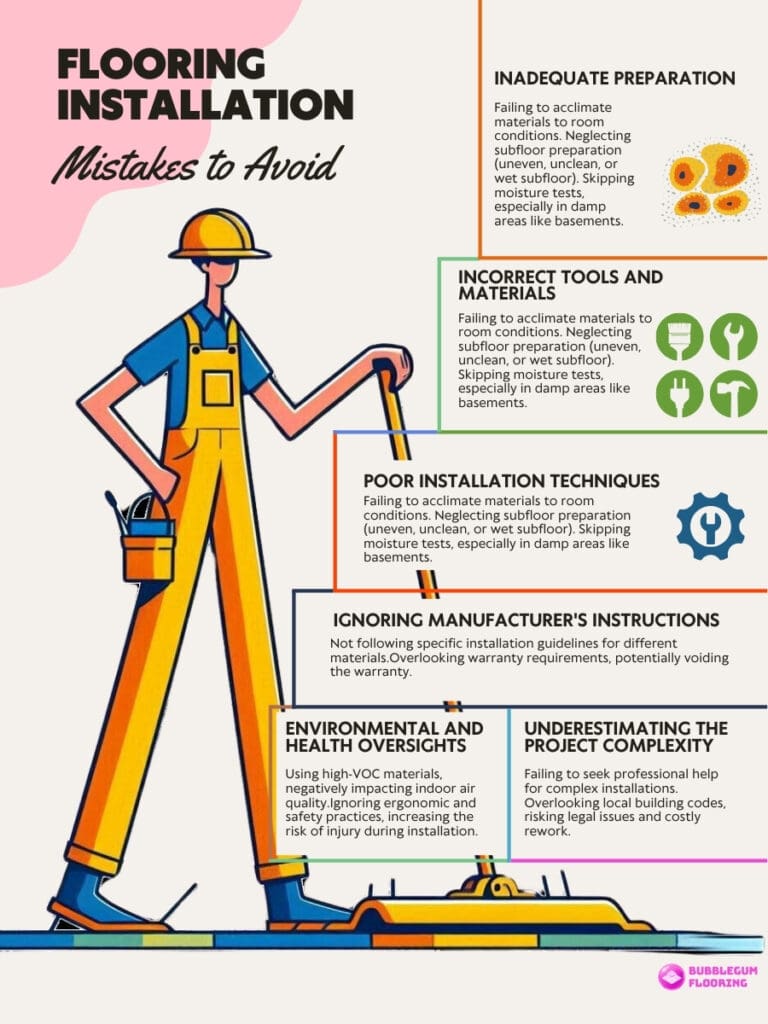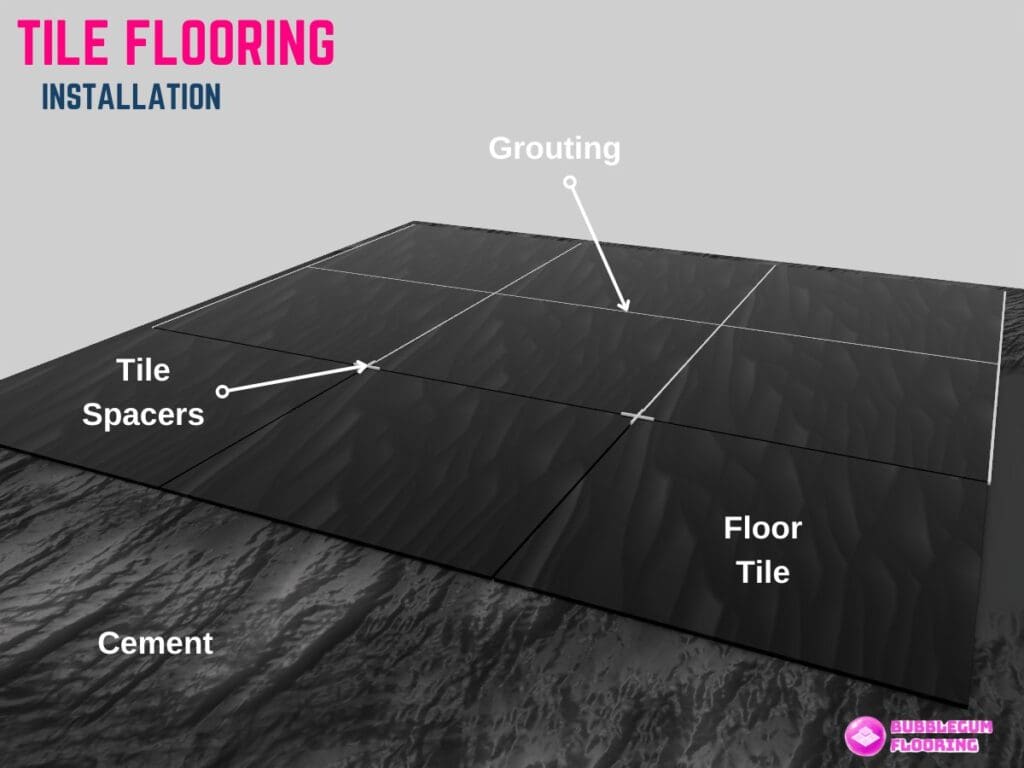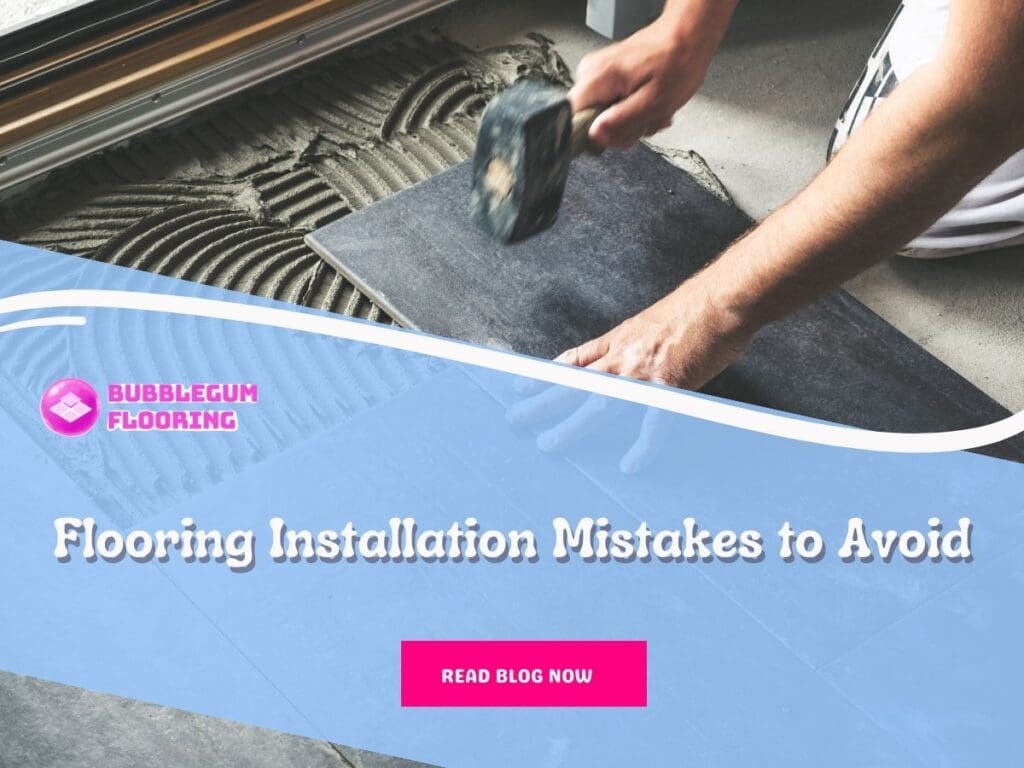When it comes to home improvement, flooring installation is a significant undertaking that can dramatically transform the look and feel of any space. However, this task is not without its challenges, and even small mistakes can lead to big problems down the line.
Understanding and avoiding common flooring installation mistakes is crucial for homeowners, contractors, and DIY enthusiasts alike. This article aims to highlight key mistakes to avoid, covering various aspects from preparation to the final touches, across different types of flooring materials like hardwood, laminate, tile, and carpet.
By being aware of these potential pitfalls and “Flooring Installation Mistakes to Avoid,” you can ensure a smoother installation process and enjoy a flawless, durable floor for years to come. Let’s start!

1. Inadequate Preparation
Effective preparation is essential for a successful flooring installation. Here are some mistakes to avoid:
- Understanding the Importance of Preparation: The initial stage of any flooring project involves readying the area and materials. This includes acclimating materials like hardwood and laminate to the specific conditions of the room, such as its temperature and humidity levels. Proper acclimation is vital to prevent issues like warping or the formation of gaps as the material adapts to its new environment.
- Subfloor Preparation: The subfloor, serving as the foundation for your new flooring, demands careful attention. It must be level, clean, and completely dry before proceeding. Neglecting this step can lead to a range of problems, from uneven installation to the potential for mold growth beneath the flooring, due to any residual moisture or debris.
- Conducting Moisture Tests: In environments prone to dampness, such as basements, moisture testing is a critical preventative measure. It helps avert issues like mold and warping that can arise from excessive moisture, ensuring a stable and healthy environment for your new flooring.
Thorough preparation is the key to avoiding future flooring problems. Acclimating the materials, preparing the subfloor, and conducting moisture tests are fundamental steps that set the stage for a smooth and successful flooring installation.
2. Incorrect Tools and Materials
Utilizing appropriate tools and materials is crucial for a successful flooring installation.
- Choosing the Right Adhesives and Tools: Selecting the correct adhesive is crucial for ensuring proper adherence and durability of the flooring. Different flooring materials require specific adhesives to maintain their integrity and appearance. Similarly, using the right tools is essential for precise cuts and fitting, which contribute significantly to a professional and polished finish.
- Importance of Expansion Gaps: For wood and laminate floors, allowing for expansion gaps is critical. These gaps around the room’s perimeter let the flooring expand and contract with changes in temperature and humidity. Without these gaps, floors are prone to buckling and warping, compromising both aesthetics and functionality.
- Underlayment Quality: The underlayment serves as a foundation for laminate and engineered wood floors. It’s not just a layer beneath the flooring; it provides essential insulation, soundproofing, and ensures a level surface. Investing in a high-quality underlayment is key to enhancing the floor’s comfort, longevity, and overall performance.
In summary, the selection of correct adhesives, tools, and materials like underlayment, along with attention to details like expansion gaps, plays a pivotal role in the success and longevity of a flooring installation project.
3. Poor Installation Techniques
The importance of proper installation techniques cannot be overstated in ensuring the flooring’s longevity and aesthetic appeal.
- Accuracy in Measurements and Cuts: Precise measuring and cutting are vital. Errors in these areas can result in unsightly gaps, over-reliance on fillers, or a visibly uneven surface. It’s crucial to double-check measurements and cut with precision to avoid these pitfalls.
- Aligning and Laying Out the Flooring: Careful planning and execution are needed in the alignment and layout, particularly with tile flooring. Misalignment can detract from the floor’s appearance and compromise its structural integrity. Attention to detail in this step is key to achieving a polished and structurally sound finish.
- Avoiding Rushing the Process: A patient and methodical approach to installation pays off. Hastily laid flooring often leads to issues like visible seams, unevenness, or misaligned patterns. Slow and steady work ensures a uniform, attractive finish, free from these common errors.
In essence, meticulous attention to measurements, alignment, and the overall pace of work is essential for a successful flooring installation that combines durability with visual appeal.
4. Overlooking Finishing Details
Finishing details significantly impact both the floor’s aesthetics and its functionality. Improper sealing and grouting, particularly in tile floors, can lead to water damage and reduce the floor’s durability.

Transitions and trims are not just decorative; they cover expansion gaps and protect the edges of the flooring, ensuring a finished look and preventing damage. Post-installation, the flooring requires proper cleaning and maintenance to preserve its appearance and extend its lifespan.
Mistakes to avoid include:
- Improper Sealing and Grouting: For tile floors, ensure proper sealing and grouting to prevent water damage and maintain durability.
- Neglecting Transitions and Trims: Transition strips and trims not only provide a finished look but also cover expansion gaps and protect edges.
- Inadequate Cleaning and Maintenance Post-Installation: Proper cleaning and maintenance extend the life of the flooring and maintain its appearance.
5. Ignoring Manufacturer’s Instructions
Overlooking the manufacturer’s instructions is a major mistake in flooring installation. Each type of flooring comes with specific guidelines that are essential for proper installation and maintaining the product’s longevity.
Common oversights include:
- Not Following Specific Installation Guidelines: Different materials have unique installation requirements. Ignoring these can lead to improper installation, affecting both appearance and durability.
- Overlooking Warranty Requirements: Installation methods often dictate warranty terms. Using incorrect techniques or materials can void the warranty without protection against potential defects or issues.
In summary, adhering to the manufacturer’s instructions is crucial for a successful installation and to ensure the longevity and warranty of the flooring.
6. Underestimating the Project Complexity
The complexity of flooring installation projects is often underestimated, leading to significant issues.
- Not Seeking Professional Help When Necessary: Many DIY enthusiasts may not realize the intricacies involved in flooring installation. Complex patterns, specific material characteristics, or challenging subfloor conditions often necessitate the skills and experience of a professional. It’s essential to recognize when a project is beyond your expertise and seek professional assistance to avoid costly mistakes and ensure a high-quality finish.
- Overlooking Local Building Codes: Compliance with local building codes is crucial, especially in commercial spaces or rental properties. These codes are in place to ensure safety and quality standards. Ignoring them can lead to legal complications, fines, and the need for expensive rework. It’s important to research and adhere to these regulations to ensure your installation is up to code.
In essence, acknowledging and addressing the complexity of flooring installation is vital. It involves understanding when to call in professionals and the importance of adhering to local building codes, ensuring both the quality and legality of the installation process.
7. Environmental and Health Oversights
Environmental and health considerations are crucial yet frequently neglected during flooring installation.
- Use of High VOC Materials: Many flooring materials, adhesives, and finishes contain Volatile Organic Compounds (VOCs), which can significantly affect indoor air quality. Choosing low-VOC or VOC-free options is essential for maintaining a healthier indoor environment and reducing the risk of respiratory problems and other health issues associated with poor air quality.
- Neglecting Ergonomics and Safety: The physical process of installing flooring requires attention to ergonomics and safety to prevent injuries. This includes using proper lifting techniques, ensuring adequate ventilation, and wearing appropriate safety gear. Overlooking these factors can lead to physical strain or accidents, making safety a paramount concern.
In summary, being mindful of the environmental impact and health implications of flooring materials and installation practices is vital.
Opting for safer, low-VOC materials and adhering to ergonomic and safety guidelines not only protects the environment but also ensures the well-being of those involved in the installation process.


